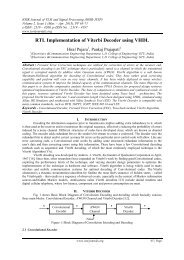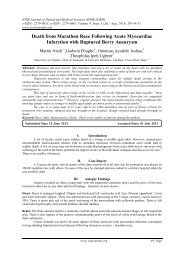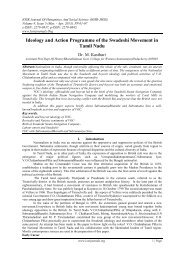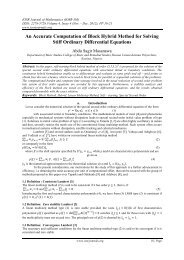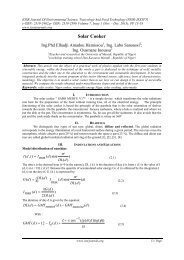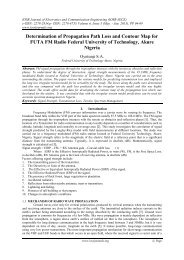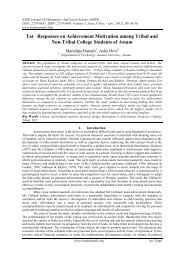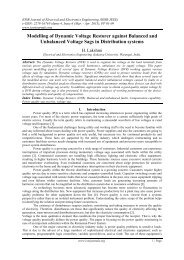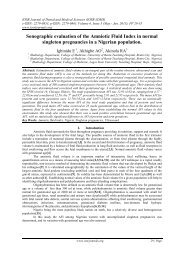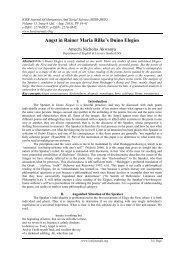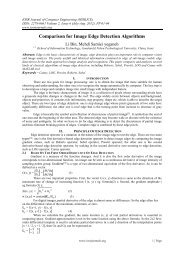Design Compatibility of Classroom Furniture in Urban and ... - IOSR
Design Compatibility of Classroom Furniture in Urban and ... - IOSR
Design Compatibility of Classroom Furniture in Urban and ... - IOSR
You also want an ePaper? Increase the reach of your titles
YUMPU automatically turns print PDFs into web optimized ePapers that Google loves.
<strong>Design</strong> <strong>Compatibility</strong> Of <strong>Classroom</strong> <strong>Furniture</strong> In <strong>Urban</strong> And Rural Preschools<br />
II. Research Methods<br />
2.1. Sample Selection<br />
Lucknow District <strong>of</strong> Uttar Pradesh, India was selected purposively to conduct the present study.<br />
Multistage r<strong>and</strong>om sampl<strong>in</strong>g technique was used to select the sample for the present study. The list <strong>of</strong> zones <strong>and</strong><br />
wards were obta<strong>in</strong>ed from the Lucknow Municipal Corporation (Census, 2001). Out <strong>of</strong> the exist<strong>in</strong>g six zones,<br />
two zones were selected r<strong>and</strong>omly by us<strong>in</strong>g r<strong>and</strong>om sampl<strong>in</strong>g technique. From each zone, two wards were<br />
selected r<strong>and</strong>omly after obta<strong>in</strong><strong>in</strong>g a list <strong>of</strong> them. From the selected areas, the lists <strong>of</strong> schools were obta<strong>in</strong>ed <strong>and</strong><br />
from the exist<strong>in</strong>g no <strong>of</strong> schools, ten preschools each from urban <strong>and</strong> rural areas were selected r<strong>and</strong>omly by us<strong>in</strong>g<br />
r<strong>and</strong>om sampl<strong>in</strong>g technique. From each preschool, the students study<strong>in</strong>g <strong>in</strong> nursery, <strong>in</strong> the age group <strong>of</strong> below 6<br />
years were identified <strong>and</strong> 20 respondents <strong>in</strong>clusive <strong>of</strong> 10 boys <strong>and</strong> 10 girls were selected r<strong>and</strong>omly us<strong>in</strong>g r<strong>and</strong>om<br />
sampl<strong>in</strong>g technique. The sample size for the present study was computed us<strong>in</strong>g the given formula- n = z2 pq<br />
.<br />
E 2<br />
The total sample size is fixed as 400.<br />
2.2. Data Collection<br />
Data sheet was prepared to acquire the anthropometric dimensions <strong>of</strong> sample <strong>and</strong> the measurement <strong>of</strong><br />
exist<strong>in</strong>g furniture <strong>in</strong> both urban <strong>and</strong> rural preschools.<br />
2.3. Anthropometric Measurements<br />
To identify the mismatch between <strong>in</strong>dividual body dimensions <strong>and</strong> exist<strong>in</strong>g furniture the<br />
anthropometric dimensions were measured as given <strong>in</strong> table-1 with the use <strong>of</strong> measur<strong>in</strong>g tape <strong>in</strong> <strong>in</strong>ches. All the<br />
anthropometric measurements were taken with the subject <strong>in</strong> a relaxed <strong>and</strong> erect posture. The subjects were<br />
wear<strong>in</strong>g light clothes <strong>and</strong> were bare footed dur<strong>in</strong>g measurement.<br />
Table -1 Def<strong>in</strong>ition <strong>of</strong> Measured Anthropometric Dimensions to Identify the Mismatch<br />
S. Dimensions <strong>in</strong> Sitt<strong>in</strong>g<br />
Def<strong>in</strong>ition<br />
No. Posture<br />
1 Elbow rest height Height from the top <strong>of</strong> the sitt<strong>in</strong>g surface to the bottom <strong>of</strong> the tip <strong>of</strong><br />
the elbow.<br />
2 Popliteal height Popliteal angle po<strong>in</strong>t at the underside to the thigh immediately beh<strong>in</strong>d<br />
the knee, where the tendon <strong>of</strong> biceps <strong>and</strong> femor muscle <strong>in</strong>sert.<br />
3 Buttock popliteal<br />
length<br />
Horizontal distance from the rear most surface <strong>of</strong> the buttock to the<br />
back <strong>of</strong> the lower leg.<br />
4 Hip breadth Maximum horizontal distance across the hips.<br />
[4, 5]<br />
2.4. Dimensions <strong>of</strong> Exist<strong>in</strong>g <strong>Furniture</strong><br />
The dimensions <strong>of</strong> classroom furniture, <strong>in</strong> r<strong>and</strong>omly selected preschools were also measured as given<br />
<strong>in</strong> table 2 with the use <strong>of</strong> measur<strong>in</strong>g tape <strong>in</strong> <strong>in</strong>ches. The follow<strong>in</strong>g variables represent relevant dimensions <strong>of</strong><br />
classroom furniture (chairs, desks):-<br />
Table 2- <strong>Classroom</strong> <strong>Furniture</strong> Measurements<br />
S. No. Dimensions Def<strong>in</strong>itions<br />
1 Chair height Vertical distance from the floor to the topmost part <strong>of</strong> the chair.<br />
2 Chair depth Horizontal distance <strong>of</strong> the sitt<strong>in</strong>g surface from the back <strong>of</strong> the seat to the front<br />
<strong>of</strong> the seat.<br />
3 Chair breadth Horizontal distance from left h<strong>and</strong> side <strong>of</strong> the seat <strong>and</strong> the right h<strong>and</strong> side or<br />
vice versa.<br />
4 Desk height Vertical distance from the floor to the top <strong>of</strong> the front edge <strong>of</strong> the desks.<br />
5 Desk depth Horizontal distance from the front <strong>of</strong> the desk to the back at the top <strong>of</strong> the<br />
front edge <strong>of</strong> the shelf under the writ<strong>in</strong>g surface.<br />
6 Desk breadth Horizontal distance from left h<strong>and</strong> side <strong>of</strong> the seat <strong>and</strong> the right h<strong>and</strong> side or<br />
vice versa.<br />
[5]<br />
2.5. Data Analysis<br />
The anthropometric data was statistically analyzed <strong>in</strong> averages, St<strong>and</strong>ard Deviation <strong>and</strong> t- test statistic<br />
us<strong>in</strong>g SPSS. The mismatch between anthropometric dimensions <strong>of</strong> children <strong>and</strong> exist<strong>in</strong>g furniture was analyzed<br />
based on the equations which were given by various researchers to def<strong>in</strong>e mismatch, as listed below-<br />
Seat height mismatch- when the seat height was either >95% or 95% or



